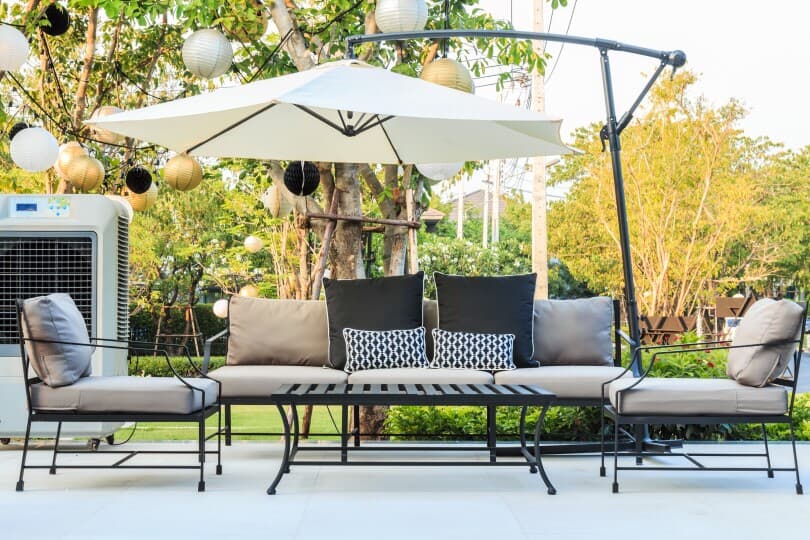How to Buy the Right Patio Umbrella

A patio umbrella is the perfect finishing touch to provide shade and comfort to guests when you gather outdoors. Warm weather will be upon us before we know it, so now is the time to start shopping around. Follow our tips for buying a patio umbrella to ensure you find the perfect solution that is both functional and stylish.
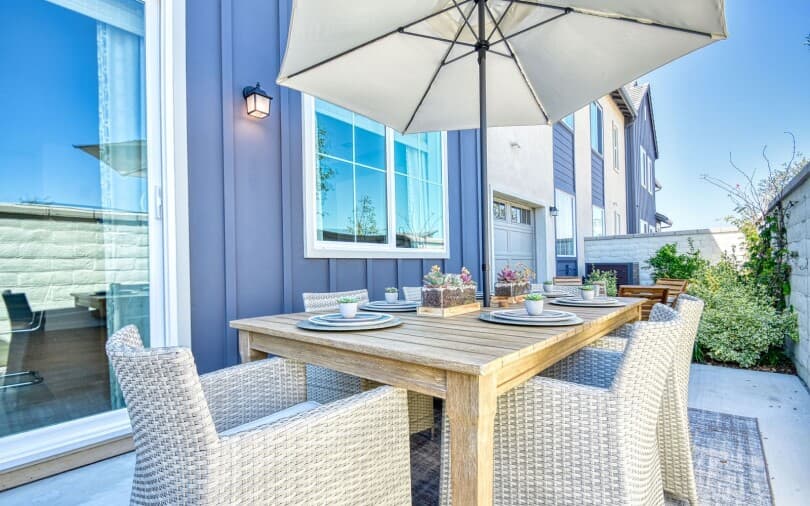
Assess the Location
Before you can start shopping, you need to figure out where you want to place your patio umbrella. Are you using it for your dining table? Does your dining table have a pre-drilled hole or does the umbrella need to be offset? Are you trying to create shade over an outdoor lounge area? How big is the furniture the umbrella will be covering? Are there any overhead obstacles such as a patio cover or roof overhang? Are there any nearby fire features such as a grill or fire pit?
Knowing where you want to use your patio umbrella will help you better decide the type, size, material, pole, and more.
Patio Umbrella Types
While there can be variations of tilting and materials, there are two basic types of patio umbrellas: market patio umbrellas and offset patio umbrellas.
Market Patio Umbrellas
These are the umbrellas you’ll typically see at outdoor restaurants and markets. A market patio umbrella has a straight pole that is positioned in the center of the umbrella and sits in a base on the ground. You can place the umbrella pole in the center of a patio table or use the umbrella alone.
Offset Patio Umbrellas
If you’re looking to shade a conversation set or simply don’t want an umbrella pole in the middle of your space, an offset patio umbrella is the solution for you. These versatile deck umbrellas feature a pole located off to the side, rather than down the middle. Many offset umbrellas have a shade that can pivot side to side and some can even rotate 360°.
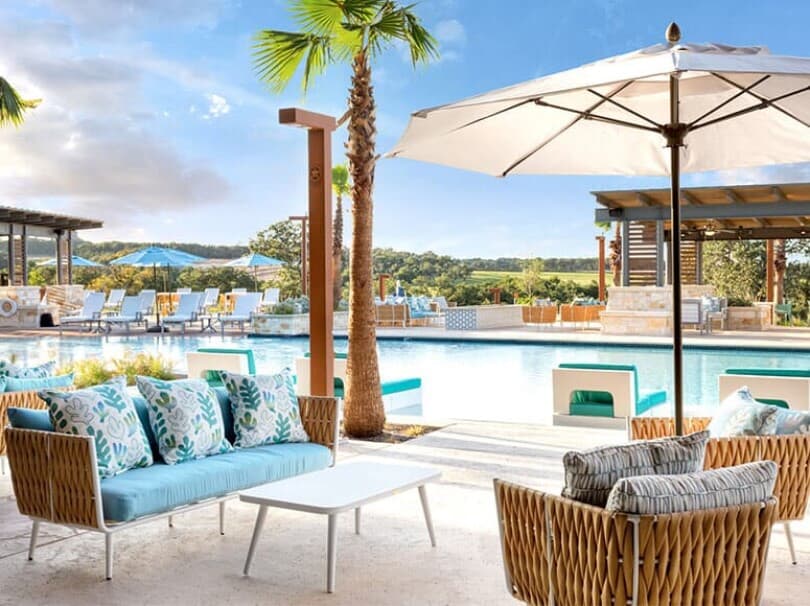
Patio Umbrella Shapes
There are three popular umbrella shapes: round (sometimes referred to as an octagon), square, and rectangle. The shape of the space you are trying to cover will typically dictate the shape of your patio umbrella. If you are trying to cover a rectangular dining table, a larger, rectangular patio umbrella would provide the best coverage. If you’re trying to cover two side-by-side chaise lounges, a square or round umbrella would be a good choice.
There’s no right or wrong when it comes to deciding your umbrella’s shape – as long as the area that needs to be shaded is covered sufficiently. In fact, introducing the opposite shape can create visual balance if one already dominates the space. For example, if you have a lot of rounded elements, a rectangular or square patio umbrella may help break that up.

Patio Umbrella Sizing Recommendations
The size of your canopy determines how much shade it provides, so it’s essential to choose the correct dimensions. As a general rule of thumb, you’ll want a canopy that is a minimum of two feet wider on each side than the space you’d like to cover.
If you’re shading a table, start by pulling out the chair as if they were occupied and measure the space around them. Your umbrella needs to be at least two feet wider than this space.
Small: 6’ – 8’ Canopy
Small canopies work well with compact seating areas, small patios, and tables.
- Less than 30” table: A 6’ canopy will be sufficient, but a 7’ will provide more coverage if you have the space.
- 31” – 38” table: A 7’ to 8’ patio umbrella is ideal for tables no larger than 38”
Medium: 9’ – 10’ Canopy
Medium canopies are the most common for standard patios, seating areas, and table sizes. They also work well for small patio tables as they’ll provide more than enough shade.
- 40” – 44” table: A 9’ patio umbrella will work well for these size tables with up to eight chairs
- Less than 48” table: A 10’ umbrella canopy will provide plenty of shade for tables up to 48”, though you will still only accommodate around eight chairs.
Large: 11’+ Canopy
Large canopies are a must-have for expansive seating areas and sizable tables. If you have the room, they’re a luxurious nice-to-have in small and medium patio settings as they provide an abundance of shade.
- 48” – 60” table: An 11’ umbrella canopy will work well for large tables that seat up to 10 people.
- 60”+ table: For even larger tables, you’ll need a patio umbrella with at least a 12’ canopy. Most large canopies come in sizes up to 16’.
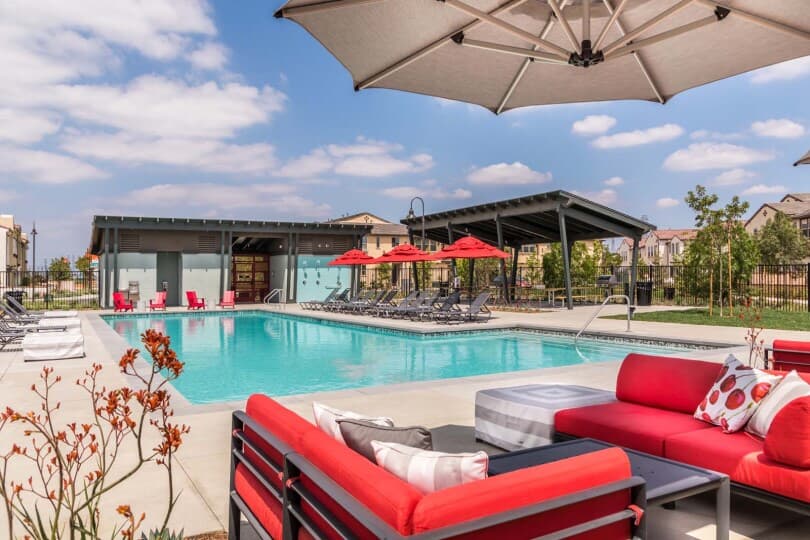
Patio Umbrella Canopy Materials
Outdoor-rated textiles can have dramatic ranges with quality, durability, price, and their ability to weather the elements over time. You’ll want a fabric that provides complete UV protection and is water-, fade-, dirt-, mold-, mildew-, and weather-resistant.
Acrylic
Acrylic fabric is durable, colorfast, and offered in a wide variety of colors and patterns. Sunbrella is the industry leader in outdoor fabric and offers matching outdoor cushions and accent pillows to ensure you have a cohesive look throughout your outdoor space. It’s a high-quality material that will last for years, but that comes at a more expensive cost.
Polypropylene
Also known as Olefin, polypropylene is a budget-friendly option that doesn’t sacrifice quality. It’s made of highly durable synthetic fibers that will last for years to come as long as it is cared for properly. Polypropylene has better fade-resistance than polyester or cotton, without the high cost of acrylic.
Polyester
Polyester provides an impressive performance at a budget-friendly price. It’ll offer fade-, rot-, and mildew-resistance for years with proper care. Major brands include Pacifica and O’Bravia and you can choose from a wide selection of stylish colors and patterns.
Thatch
A playful alternative to traditional fabrics, thatch is typically made from polypropylene strips sewn into a spun polyester base cloth. It will not rot, mildew or attract insects and is low maintenance – just hose it down and allow to air dry.
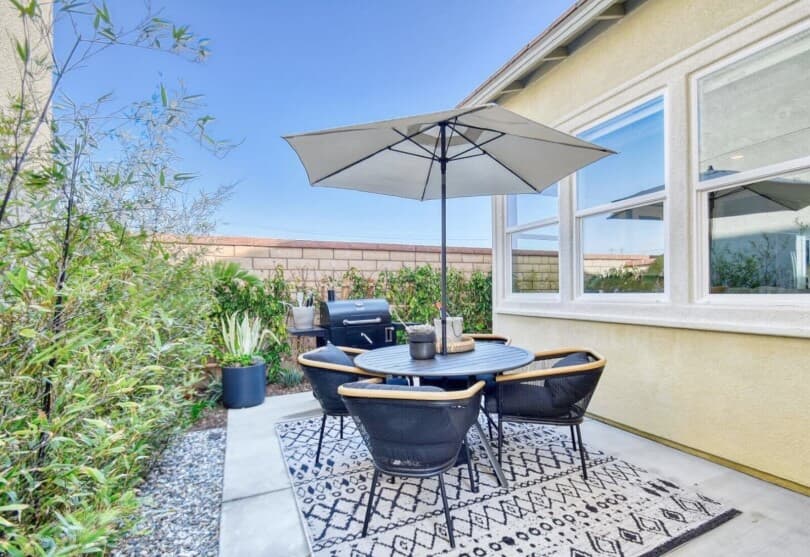
Picking an Umbrella Frame & Pole Material
The material you choose will play a major role in your patio umbrella’s strength, weather-resistance, and overall look. There are two primary materials to choose from: woods like teak, eucalypts, or bamboo and metals like aluminum or steel.
Wood
Wooden frames have a timeless aesthetic, lending a natural look that works within a lush, green setting. They pair well with other wooden outdoor furniture so you can ensure a cohesive feel in your space. Umbrellas with wood frames often come with higher price points and may require refinishing to prevent decay, insect, and weather damage. They’re also less durable than metal options and can break in extremely high winds.
Metal
Aluminum is the most durable and versatile of umbrella pole options as it is rust-resistant and extremely strong. They feature easy-to-operate crank lifts, many have a tilt feature, and come in a wide range of finishes.
Steel umbrellas offer the same strength and feature benefits of aluminum, but at a lower cost. This is because steel doesn’t have the same rust-resistance so they may not look as new for as long. Steel umbrellas tend to be heavier which works well in windier climates.

Patio Umbrella Lift Types
There are three types of umbrella lift systems from which to choose:
- Push-up: User grabs the collar (where the canopy ribs come together around the center pole), pushes it up, and locks it into place with a pin.
- Crank: Located around the center of the pole, the crank is turned until the shade is fully opened.
- Pulley: An integrated cord or rope is pulled to expand and open the umbrella canopy. The open shade is typically held in place with a pin.
Patio Umbrella Tilt Method
A tilting umbrella can be angled to protect against sunlight from a specific direction. There are three types of tilt mechanisms available:
- Push-button: A button located on the upper half of the pole allows you to tilt the canopy in two directions.
- Crank or auto: Using the same crank used to open the shade, continuing to turn will pivot the canopy.
- Collar: A ring or collar located just above the crank mechanism is twisted clockwise to tilt the shade.
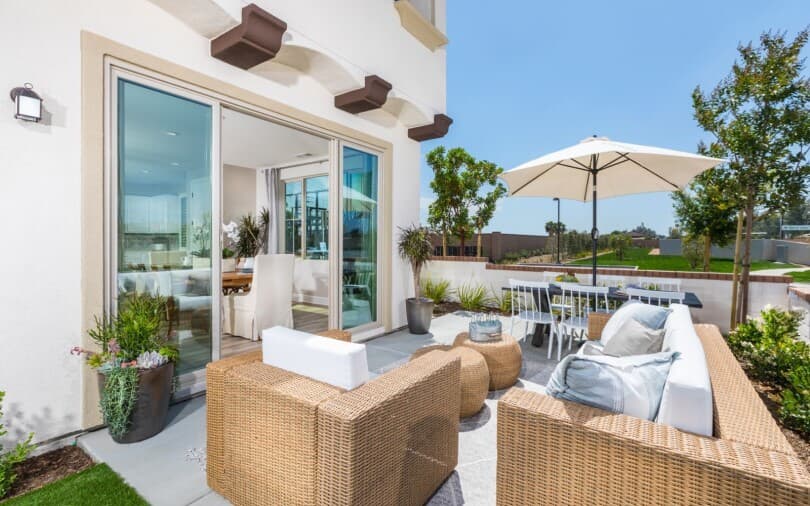
Patio Umbrella Base
You don’t want to put all the time and energy into finding the perfect patio umbrella and skimp on the base. You must properly secure it to prevent tipping or blowing away in high winds. Even if your dining table has an umbrella hole, you’ll need a base for stability and reinforcement.
A good way to determine the minimum weight for your umbrella stand is to multiply the width of your canopy by 10. For example, a 7.5’ umbrella would need a minimum of a 75 lb. umbrella stand; a 9’ umbrella would need a minimum of a 90 lb. stand. If you live in a high-wind area, the heavier, the better.
Patio Umbrella Maintenance
A patio umbrella is an investment in your home and outdoor décor, so you want to keep it in good shape for years to come. Like anything else in your home, this means keeping up on care and maintenance.
- Always close the umbrella and watch for wind
- Rinse your umbrella and wipe it down
- Don’t force your umbrella open; it should open gently and if it doesn’t, there may be something caught and forcing it could damage the mechanics
- Use an umbrella cover
- Store somewhere like the garage or a storage shed during the off-season

Warm, sunny months call us outside to enjoy al fresco dining, lounging, or gathering with friends. Whether you place a patio umbrella on your deck or use it poolside, a nice shady spot is a welcome escape from the sun.
Be sure to follow the Brookfield Residential blog for more design advice, homebuying insights, mortgage tips, and more. Explore where we build and connect with our sales team when you’re ready to learn more. We’ll be expecting you!

